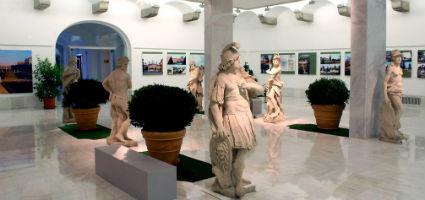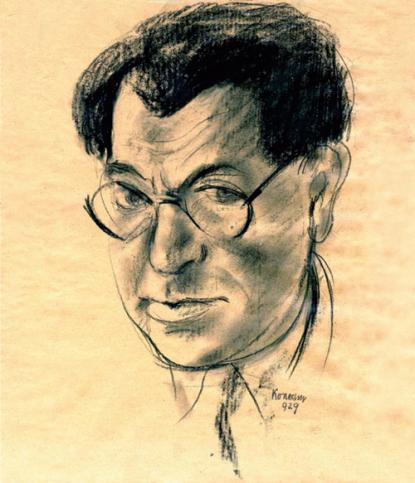2025. December 23. Tuesday
National Office of Cultural Heritage - Heritage Gallery - Budapest
 |
Address: 1014, Budapest Táncsics Mihály utca 1.
Phone number: (1) 225-4800
E-mail: koh@koh.hu
Opening hours: Mon-Sat 9-17
|
The exhibition has closed for visitors.
2008.07.25. - 2008.09.14.
The Ybl Prize awarded architect and painter Tibor Vákár was born on 14 May 1908 in Gyergyószentmiklós. From 1926 to 1930, he studied architecture at the Palatine Joseph Royal Polytechnic and Economy University. From 1930 to 1932, he attended the Royal Collage of Fine Arts.

After graduation, he began working at an architecture office where his colleagues were Pál Ligeti, Farkas Molnár, László Mohácsi, Ferenc Kende, István Medgyasszay. From 1936 he designed military buildings, holiday houses and martial establishments employed by the "Honvéd Central Architecture Department".
In 1937 he began working at the Structural Architecture Department of the Mayor's Office of Budapest where he advanced higher and higher on the hierarchical structure.
From 1938 to 1940 he worked in Munich on the design of the new district and buildings of the German National Railways.
From 1940 to 1943 he managed the Architecture Office in Kolozsvár, afterwards in Marosvásárhely. After the 1945, he worked on rebuilding the wartime damages in Budapest as a building engineer, among other he worked on the restoration of the Budavár Palace, civic houses and a number of national monuments.
From 1948 he was the head architect of the Budapest Design Institute. He designed bridges, hotels on the Danube Corso, spas in Buda, exhibition pavilions and the image of Budapest in large.
From 1945 to 1950 he was the professor of the University of Arts.
From 1950 he worked at the Architecture Scientific and Design Institute, later at the Architect Design Office. He was the first head architect in Budapest, Nagy-Miskolc, Székesfehérvár, Ajka, Kazincbarcika, Jászberény, Gödöllő to design the image and restore national monuments. He also worked on 30 other town's architectural images and examined national monuments
From 1952 to 1954 he was the head architect of the Design Office of Debrecen of which he was also the assistant manager. His task involved the reconstruction of national monuments and creation of architectural design of the town.
In 1957 he was the head architect of the Estate Management Company of Veszprém. From 1958 he worked at the Department of National Monuments of Budapest.
From 1961 to 1968 he was forced to work for the "Mélyépterv" where he had to manage the location issues of industrial buildings and water towers.
From 1968 he worked as a designer at the National Department of the BUVÁTI. His task included the design of the Danube Corso and the Vörösmarty Square. In 1970 he was employed by the Open Air Ethnography Museum of Szentendre where he had to fulfil surveys regarding the state of location where exhibition buildings were designed to be built. Later on he worked for the National Graveyard Committee.
In 1975 he was chosen the Life Member of the Association des Artistes of Paris.
After retiring, he undertook the design of a number of private- and public buildings. In 1988 he participated in the application of announced for the location of the National Theatre. In 1992-94 he was commissioned to design the Chapel at the "Gyilkos Lake" of the Roman Catholic Parish in Gyergyószentmiklós.
He was awarded with the Podmaniczky Prize in 1986. he received a medal for National Monument Protection in 1995, in 1991 he received the Ybl Prize, in 1995 the Small Cross of the Merit of Hungarian Republic. He was also acknowledged for his life work for Budapest. In 2000, he was awarded with the title "freeman of Gyergyószentmiklós".
Tibor Vakár began his career as an employee of the town of Budapest. Despite all hardship, wards and economic difficulties, he fulfilled his task with excellence. He served 4.5 years in the army. From 1948 to 1968 he lost 11 jobs. Despite of all these, his achievements are outstanding that his colleagues acknowledged only in the last few years of his life.

After graduation, he began working at an architecture office where his colleagues were Pál Ligeti, Farkas Molnár, László Mohácsi, Ferenc Kende, István Medgyasszay. From 1936 he designed military buildings, holiday houses and martial establishments employed by the "Honvéd Central Architecture Department".
In 1937 he began working at the Structural Architecture Department of the Mayor's Office of Budapest where he advanced higher and higher on the hierarchical structure.
From 1938 to 1940 he worked in Munich on the design of the new district and buildings of the German National Railways.
From 1940 to 1943 he managed the Architecture Office in Kolozsvár, afterwards in Marosvásárhely. After the 1945, he worked on rebuilding the wartime damages in Budapest as a building engineer, among other he worked on the restoration of the Budavár Palace, civic houses and a number of national monuments.
From 1948 he was the head architect of the Budapest Design Institute. He designed bridges, hotels on the Danube Corso, spas in Buda, exhibition pavilions and the image of Budapest in large.
From 1945 to 1950 he was the professor of the University of Arts.
From 1950 he worked at the Architecture Scientific and Design Institute, later at the Architect Design Office. He was the first head architect in Budapest, Nagy-Miskolc, Székesfehérvár, Ajka, Kazincbarcika, Jászberény, Gödöllő to design the image and restore national monuments. He also worked on 30 other town's architectural images and examined national monuments
From 1952 to 1954 he was the head architect of the Design Office of Debrecen of which he was also the assistant manager. His task involved the reconstruction of national monuments and creation of architectural design of the town.
In 1957 he was the head architect of the Estate Management Company of Veszprém. From 1958 he worked at the Department of National Monuments of Budapest.
From 1961 to 1968 he was forced to work for the "Mélyépterv" where he had to manage the location issues of industrial buildings and water towers.
From 1968 he worked as a designer at the National Department of the BUVÁTI. His task included the design of the Danube Corso and the Vörösmarty Square. In 1970 he was employed by the Open Air Ethnography Museum of Szentendre where he had to fulfil surveys regarding the state of location where exhibition buildings were designed to be built. Later on he worked for the National Graveyard Committee.
In 1975 he was chosen the Life Member of the Association des Artistes of Paris.
After retiring, he undertook the design of a number of private- and public buildings. In 1988 he participated in the application of announced for the location of the National Theatre. In 1992-94 he was commissioned to design the Chapel at the "Gyilkos Lake" of the Roman Catholic Parish in Gyergyószentmiklós.
He was awarded with the Podmaniczky Prize in 1986. he received a medal for National Monument Protection in 1995, in 1991 he received the Ybl Prize, in 1995 the Small Cross of the Merit of Hungarian Republic. He was also acknowledged for his life work for Budapest. In 2000, he was awarded with the title "freeman of Gyergyószentmiklós".
Tibor Vakár began his career as an employee of the town of Budapest. Despite all hardship, wards and economic difficulties, he fulfilled his task with excellence. He served 4.5 years in the army. From 1948 to 1968 he lost 11 jobs. Despite of all these, his achievements are outstanding that his colleagues acknowledged only in the last few years of his life.
